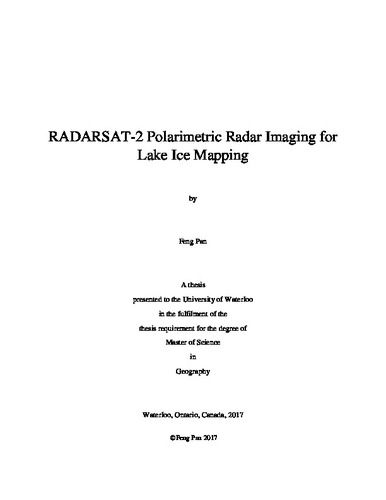| dc.contributor.author | Pan, Feng | |
| dc.date.accessioned | 2017-11-21 20:56:29 (GMT) | |
| dc.date.available | 2017-11-21 20:56:29 (GMT) | |
| dc.date.issued | 2017-11-21 | |
| dc.date.submitted | 2017-11-13 | |
| dc.identifier.uri | http://hdl.handle.net/10012/12658 | |
| dc.description.abstract | Changes in lake ice dates and duration are useful indicators for assessing long-term climate trends and variability in northern countries. Lake ice cover observations are also a valuable data source for predictions with numerical ice and weather forecasting models. In recent years, satellite remote sensing has assumed a greater role in providing observations of lake ice cover extent for both modeling and climate monitoring purposes. Polarimetric radar imaging has become a promising tool for lake ice mapping at high latitudes where cloud cover and polar darkness severely limit observations from optical sensors. In this study, we assessed and characterized the physical scattering mechanisms of lake ice from fully polarimetric RADARSAT-2 datasets obtained over Great Bear Lake, Canada, with the intent of classifying open water and ice cover during the freeze-up and break-up periods. Model-based and eigen-based decompositions were employed to construct the coherency matrix into deterministic scattering mechanisms, and secondary physical parameters were generated following the polarimetric decompositions. This study presents an application of the Markov Random Field by introducing radar signals and polarimetric parameters as features. These features were labeled using the entropy-alpha Wishart classifier. We show that the selected polarimetric parameters can help with interpretation of radar-ice/water interactions and can be used successfully for water-ice segmentation. As more satellite SAR sensors are being launched or planned, such as the Sentinel-1a/b series and the upcoming RADARSAT Constellation Mission, the rapid volume growth of data and their analysis require the development of robust automated algorithms. The approach developed in this study was therefore designed with the intent of moving towards fully automated mapping of lake ice for consideration by ice services. | en |
| dc.language.iso | en | en |
| dc.publisher | University of Waterloo | en |
| dc.subject | Polarimetry | en |
| dc.subject | Radar | en |
| dc.subject | Machine Learning | en |
| dc.subject | Lake Ice | en |
| dc.title | RADARSAT-2 Polarimetric Radar Imaging for Lake Ice Mapping | en |
| dc.type | Master Thesis | en |
| dc.pending | false | |
| uws-etd.degree.department | Geography and Environmental Management | en |
| uws-etd.degree.discipline | Geography | en |
| uws-etd.degree.grantor | University of Waterloo | en |
| uws-etd.degree | Master of Science | en |
| uws.contributor.advisor | Duguay, Claude | |
| uws.contributor.affiliation1 | Faculty of Environment | en |
| uws.published.city | Waterloo | en |
| uws.published.country | Canada | en |
| uws.published.province | Ontario | en |
| uws.typeOfResource | Text | en |
| uws.peerReviewStatus | Unreviewed | en |
| uws.scholarLevel | Graduate | en |

